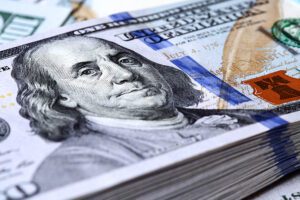
The U.S. dollar is getting stronger against the euro and the pound sterling in trading on Friday, getting cheaper against the yen.
The ICE-calculated index showing the dollar’s performance against six currencies (euro, Swiss franc, yen, Canadian dollar, pound sterling and Swedish krona) gained 0.11%, while the broader WSJ Dollar Index gained 0.07%.
The euro/dollar pair was trading at $1.0871 as of 8:20 a.m., up from $1.0892 at the close of the previous session.
The pound was down to $1.2380 from $1.2410 the day before.
Statistical data published on Thursday showed that the U.S. economy remains resilient despite a significant tightening of monetary policy by the Federal Reserve (Fed).
According to preliminary data from the U.S. Commerce Department, the nation’s GDP rose 2.9% on an annualized basis in the fourth quarter after climbing 3.2% in the previous quarter. The consensus analyst forecast cited by Trading Economics suggested economic growth weakened to 2.6%.
“The Commerce Department report suggests that the U.S. economy remains relatively strong despite aggressive measures by the Federal Reserve trying to slow inflation,” notes BMO Family Office chief investment officer Carol Schleif, quoted by Market Watch.
A less-than-expected slowdown in U.S. GDP growth last quarter somewhat dampened investor optimism that signals of deterioration in the U.S. economy would prompt the Federal Reserve (Fed) to further slow the pace of base interest rate increases.
The first Federal Open Market Committee (FOMC) meeting of the year will be held next week. The U.S. Central Bank raised the rate by 50 basis points (bps) in December after increasing it by 75 bps at the end of the previous four meetings.
On Friday, the market will follow the Commerce Department’s report on Americans’ income and spending for December, which includes data on consumer price movements.
According to a consensus forecast by experts quoted by Trading Economics, the PCE Core Consumer Price Index, which excludes food and energy costs, rose 0.3% in December after rising 0.2% a month earlier.
The dollar/yen dropped to 129.91 yen against 130.22 yen in previous trading.
The International Monetary Fund (IMF) recommended the Bank of Japan to consider taking measures to increase the flexibility of long-term government bond yields, noting that rising inflation risks in the country require additional room for maneuver in monetary policy.
In particular, the Japanese Central Bank could increase the target yield on 10-year government bonds, expand the range of fluctuations in the interest rates of these securities, as well as return to the quantitative target in the bond buyback program and switch to the purchase of more “short” securities, says the IMF report, published Thursday.

Oil prices rose on Friday on optimism about demand prospects thanks to signals of increased energy consumption in China and data on a weaker-than-expected slowdown in U.S. GDP growth.
Trafigura Group, one of the biggest commodity traders in the world, sees “great upside” for the oil market, noting the release of pent-up demand following the lifting of quarantine restrictions in China.
The price of March futures for Brent on London’s ICE Futures Exchange stood at $87.83 a barrel by 7:15 a.m. Friday, up $0.36 (0.41%) from the previous session’s close. Those contracts rose $1.35 (1.6%) to $87.47 a barrel at the close of trading on Thursday.
The price of WTI futures for March increased by $0.33 (0.41%) to $81.34 per barrel at electronic auctions of New York Mercantile Exchange (NYMEX). By the close of previous trading the cost of those contracts rose by $0.86 (1.1%) to $81.01 a barrel.
U.S. statistics released Thursday showed that the U.S. economy remains accommodative despite a significant tightening of monetary policy by the Federal Reserve (Fed).
According to preliminary data from the Commerce Department, fourth-quarter GDP rose 2.9 percent on an annualized basis after climbing 3.2 percent in the previous quarter. The consensus analyst forecast cited by Trading Economics suggested that economic growth had weakened to 2.6%.

The National Bank of Ukraine (NBU) expects that the grain harvest in 2023 will decrease by 15% compared to 2022 and will amount to 46 million tons, said deputy head of the National Bank of Ukraine (NBU) Serhiy Mykolaychuk.
“For this year, we assume that the grain harvest will be about 46 million tons and this is about 15% less than last year. For other crops, the situation is better. Somewhere even more than last year we allow for the harvest, somewhere less,” he said during a press briefing on Thursday.
Nikolaychuk noted that the harvest is one of the factors that the NBU took into account when revising the GDP forecast and when forecasting the trade balance and current account deficit.

Futures quotes on U.S. stock indices are rising on positive corporate news.
U.S. economic data released Thursday showed a less-than-expected slowdown in U.S. GDP growth in the fourth quarter of last year.
GDP rose 2.9 percent on an annualized basis, up from 3.2 percent in the third quarter, preliminary data from the nation’s Commerce Department showed. The consensus analyst forecast cited by Trading Economics suggested economic growth weakened to 2.6 percent.
Experts believe that signals of deterioration in the U.S. economy may prompt the Federal Reserve (Fed) to further slow the pace of base interest rate increases. The first Federal Open Market Committee (FOMC) meeting of the year will be held next week.
The U.S. Central Bank raised the rate by 50 basis points (bps) in December after increasing it by 75 bps at the end of the previous four meetings.
Tesla’s stock price jumped 8.4% in premarket trading on Thursday. The U.S. maker of electric cars recorded record net income for the fourth quarter of 2022 and significantly increased revenue.
The company also said that a group of banks opened it a $5 billion five-year revolving line of credit. The size of the line of credit may be increased by up to $2 billion.
The securities of Chevron Corp. went up 3.5%. One of the largest U.S. oil producers approved a new share buyback program worth up to $75 billion. The new program starts on April 1 and will be one of the largest in the U.S. corporate sector.
American Airlines Group shares gained 1.3%. The airline increased revenue 1.4 times in the fourth quarter of 2022, to an October-December record, thanks to a rebound in airline demand and prices. Its adjusted earnings were the highest since the third quarter of pre-Victorian 2019.
Southwest Airlines Co.’s stock price was down 2.4 percent. The air carrier ended the fourth quarter with a loss and its revenue missed forecasts.
The value of the March E-mini futures on the S&P 500 Index was up 0.38 percent at 4,047.25 points by 3:50 p.m. Thursday. The value of the March E-mini futures on the Dow Jones index had risen 0.1 percent to 3,3856 points by that time. The Nasdaq 100 index futures for March rose 0.76% to 11963 points.

The National Bank of Ukraine (NBU) has improved its inflation forecast for 2023 to 18.7% (the October forecast was 20.8%), as the market expected, the regulator’s press service said Thursday.
“The NBU forecasts a slowdown in inflation to 18.7% in 2023. This will be facilitated by continued tight monetary conditions, lower global inflation and weaker consumer demand amid power outages,” the statement explained.
It is pointed out that the receipt of announced volumes of international aid and joint actions of the NBU and the government on boosting the market of domestic debt attracting will allow to avoid emission financing of the budget deficit and to balance the currency market.
The regulator expects that inflation will slow down more quickly in the years to come due to lower security risks, a full recovery in logistics and an increase in yields.
The NBU, in particular, predicts that it will fall to 10.4 percent in 2024 and 6.7 percent in 2025.
“The main contribution to inflation in these years will have an administrative component due to the need to bring tariffs for housing and communal services to market levels,” the central bank explained.
It is noted that over the past three months the annual inflation rate has remained almost unchanged.
Stabilization of inflationary pressure was facilitated by the de-occupation of territories, the expansion of food supply, measures taken by the NBU and weaker consumer demand amid Russia’s energy terror.
At the same time, price pressures remain significant due to the aftermath of the war, including the destruction of enterprises and infrastructure and disruption of production and supply chains. Inflation expectations remained elevated despite stabilization.

Oil prices are steadily rising in trading on Thursday after slight fluctuations the previous day, investors are evaluating the prospects for demand.
The opening of the Chinese economy gives the market reason to be optimistic about the recovery in consumption this year, writes Trading Economics.
The cost of March futures for Brent at London’s ICE Futures Exchange was $86.73 a barrel by 12:54 p.m., $0.61 (0.71%) above the index at the close of the previous session.
The price of WTI futures for March crude oil on the electronic trades of the New York Mercantile Exchange (NYMEX) makes $80.76 per barrel by that time, which is $0.61 (0.76%) higher than the final value of the previous session.
In addition, traders continue to assess data on fuel reserves in the U.S.
The country’s commercial oil reserves rose 533,000 barrels last week, according to a weekly report released by the Energy Department the day before. Growth in reserves was recorded for the fifth week in a row.
Gasoline inventories increased by 1.76 million barrels while distillates decreased by 507,000 barrels.
The experts interviewed by Bloomberg expected a 1.5 barrel growth of oil reserves, an increase of gasoline reserves by 1.5 million barrels and a 1.6 million barrel decline of distillate reserves.